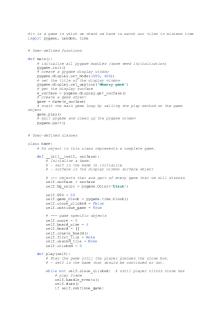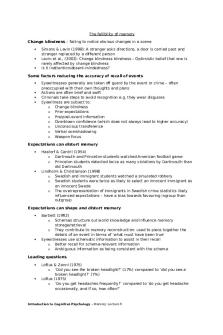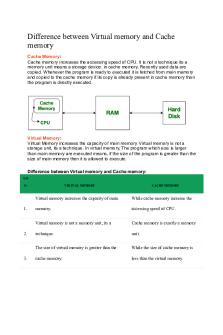Nondeclarative Memory PDF

| Title | Nondeclarative Memory |
|---|---|
| Author | quebo cabe |
| Course | Cognitive Neuroscience |
| Institution | University of Lethbridge |
| Pages | 3 |
| File Size | 52.1 KB |
| File Type | |
| Total Downloads | 66 |
| Total Views | 147 |
Summary
Nondeclarative Memory...
Description
Nondeclarative Memory priming - is a change in processing of a stimulus due to a previous encounter with the same or related stimulus - word completion skill learning - gradual improvement in performance due to the repeated practice - mirror drawing conditioning - consists of simple responses to associations between stimuli - salivating dog to rewards Priming - change in the efficacy of stimulus processing arising from a previous encounter with the same or related stimulus, in the absence of conscious awareness about the first encounter - depending on the relationship between the stimulus that generates the priming effect (the prime) and the stimulus eliciting that effect (the target), priming can be classified as: 1. direct - repetition priming; prime and target stimuli are the same perceptual - the test cue and the target are perceptually related as in the word fragment completion test conceptual - the test cue and the target are semantically or associatively related category association test 2. indirect - they are different the most typical form is semantic priming - the prime and target are semantically related Perceptual priming - depends on sensory regions of the cortex, such as visual regions of the occipital lobe - it is reduced when the format of the test stimuli changes between encoding and retrieval (study-test format shifts) - also by changes in modality or even by the introduction of more subtle changes - the greater the perceptual change, the greater the attenuation of perceptual priming - episodic memory is not affected by these kinds of shifts - levels of processing effect - episodic memory is much better for encoding tasks that promote semantic processing than perceptual processing - perceptual priming is not affected by the levels of processing manipulation - these two forms of memory depend on different brain regions - perceptual priming depends on sensory regions; the neural mechanism involves a reduction in neural responses - repetition suppression - previously encountered (primed) stimuli result in weaker hemodynamic responses - the left fusiform gyrus stores more abstract object representations - both left and right fusiform regions, like occipitotemporal areas, are concerned primarily with perceptual representations (visual), rather than with semantic representations that mediate conceptual priming - repetition suppression or neural priming → behavioral priming or enhanced processing of a stimulus - sharpening theory - when a stimulus is repeated, neurons that are not essential for processing the stimulus respond less and less, leading to reduced hemodynamic responses; the sharpened representation is smaller (fewer neurons) and more selective (only critical neurons)
Conceptual Priming - prior processing of stimulus’ conceptual aspects - sensitive to conceptual manipulations but not to perceptual - preserved in patients with medial temporal lobe damage - alzheimer’s patients are impaired - suggesting that conceptual priming is mediated by lateral temporal and prefrontal cortices (the anterior portion of the left inferior frontal gyrus - also associated with semantic processing) - the left inferior frontal gyrus showed repetition suppression when the same semantic task was performed during encoding and retrieval (within-task condition) but not when the encoding task was nonsemantic (across-task condition) Semantic Priming - the target and prime have different names but are semantically related - spreading activation - semantic memory is organized as a network in which each node corresponds to a concept and each link corresponds to an association between two concepts; when a node is accessed it becomes activated and activation spreads through the network according to the strength of the associations between neurons encoding the concepts - brain regions associated with the storage of semantic knowledge, such as left anterior temporal cortical regions - facilitate cognitive tasks in everyday life Repetition enhancement - increase in activity - whether priming is associated with repetition suppression or repetition enhancement depends on whether the stimuli employed have preexisting memory representations - for stimuli that have pre-existing memory representations, priming could reflect a modification of stored representations - repetition suppression - but for stimuli without, priming might require the creation of new representations repetition enhancement - retrieval of a new memory representation Skill learning - independent of medial temporal lobes; depends on the interaction between the neocortex and subcortical structures such as basal ganglia - motor operations, perceptual operations, cognitive operations are required Motor Skill Learning - motor sequence learning tasks - focus on the incremental acquisition of movements into wellexecuted behavior - motor adaptation tasks - focus on the process of compensating for environmental changes - serial reaction time task (SRT) - motor sequence learning task; 4 screen locations and 4 spatially mapped response keys, sequence in appearing stimulus; preserved in amnesia with medial temporal damage; impaired in patients with basal ganglia damage - implicit learning shows activation in basal ganglia - basal ganglia modulate motor and premotor cortices by controlling the starting and stopping of movements - cerebellum - coordinating movements and correcting errors - posterior parietal cortex is involved in processing spatial coordinates for guiding movement - parietal damage may cause optic ataxia - a deficit in reaching and saccade accuracy 2 phases of sequence learning:
1. early learning phase - when performance improves rapidly within a single training session; premotor cortex, pre-supplementary motor area, supplementary area, the basal ganglia (caudate), cerebellum, and the parietal cortex activated 2. advanced learning phase - improves slowly over multiple sessions; reduced global activity in most of these regions; increased activity in specific subregions of the primary motor cortex and the cerebellum - the transition from early to advanced phases involves a shift from associative to motorrelated regions of the basal ganglia and cerebellum - in motor adaptation tasks, adaptation to externally induced sensory and motor perturbations is measured - in sensory perturbations, subjects wear prism spectacles that systematically shift the visual image either horizontally or vertically - in motor perturbations, torque motors are used to create a force field that disturbs the normal movement of the handle - adaptation to novel sensory-motor relationships associated with activations in the posterior parietal cortex...
Similar Free PDFs

Nondeclarative Memory
- 3 Pages

Memory
- 3 Pages

Memory
- 5 Pages

Virtual Memory
- 58 Pages

CACHE MEMORY
- 1 Pages

Memory Psych
- 1 Pages

Virtual Memory
- 17 Pages

Memory notespack
- 16 Pages

Memory Management
- 5 Pages

9.) Memory
- 4 Pages

Memory Internal
- 34 Pages
Popular Institutions
- Tinajero National High School - Annex
- Politeknik Caltex Riau
- Yokohama City University
- SGT University
- University of Al-Qadisiyah
- Divine Word College of Vigan
- Techniek College Rotterdam
- Universidade de Santiago
- Universiti Teknologi MARA Cawangan Johor Kampus Pasir Gudang
- Poltekkes Kemenkes Yogyakarta
- Baguio City National High School
- Colegio san marcos
- preparatoria uno
- Centro de Bachillerato Tecnológico Industrial y de Servicios No. 107
- Dalian Maritime University
- Quang Trung Secondary School
- Colegio Tecnológico en Informática
- Corporación Regional de Educación Superior
- Grupo CEDVA
- Dar Al Uloom University
- Centro de Estudios Preuniversitarios de la Universidad Nacional de Ingeniería
- 上智大学
- Aakash International School, Nuna Majara
- San Felipe Neri Catholic School
- Kang Chiao International School - New Taipei City
- Misamis Occidental National High School
- Institución Educativa Escuela Normal Juan Ladrilleros
- Kolehiyo ng Pantukan
- Batanes State College
- Instituto Continental
- Sekolah Menengah Kejuruan Kesehatan Kaltara (Tarakan)
- Colegio de La Inmaculada Concepcion - Cebu




